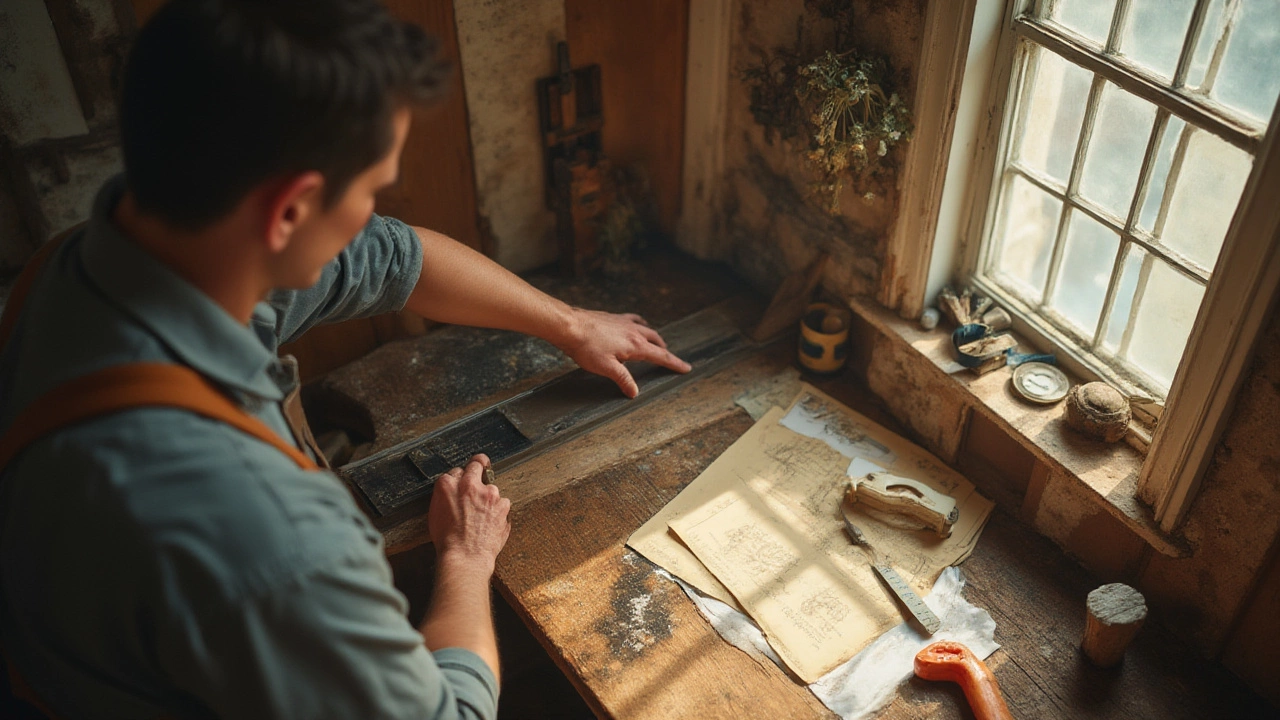Picture yourself laying out the foundation of a shed or the walls of a new room. You stretch your tape measure, double-check the plans, sweat over every inch… and yet, a tiny error snowballs into stubbornly crooked walls. Sounds familiar? This is the moment you wished you knew about the 345 rule—a time-tested trick that builders swear by when they want their corners perfectly square. Yes, there’s real math behind those straight-looking walls. The 345 rule isn't just old school wisdom; it’s the kind of practical knowledge that saves you hours of headaches later.
What Exactly Is the 345 Rule?
The 345 rule—sometimes called the "3-4-5 method"—is based on the Pythagorean Theorem, the same geometry you snoozed through in school. At its core, it helps you make a perfect right angle without needing high-tech gadgets. Here’s the trick: make a triangle with sides measuring 3 feet, 4 feet, and 5 feet. If you get those exact lengths with string, tape, or even chalk lines, the corner opposite the 5-foot side will be a 90-degree angle. This works at any scale—change it to meters, inches, even yards—just keep the ratio.
Think about it: in construction, a 90-degree angle is crucial whether you’re working on a deck, a garden fence, or framing a house. Just winging it with your eyes often leaves you with gaps, uneven doors, and that annoying feeling when nothing fits right. The 345 rule cuts through the guesswork. Laying out your building lines with confidence means your whole structure stands straight, doors close properly, and the final product just works better.
The coolest part? This method needs almost nothing: a tape measure (or three sticks, as some old hands do it), chalk, and maybe a friend to hold one end. That’s why it’s lasted centuries on jobsites, passed on from carpenter to apprentice. No batteries, apps, or equipment failures. If you want your home project to look professional, this technique is your secret weapon.
Applying the 345 Rule: Step-by-Step
On paper it sounds simple, but what about out in the backyard with uneven grass, muddy boots, and the sun in your eyes? Here’s my no-nonsense guide to using the 345 rule like a pro:
- Decide where you want your right angle—this is usually a corner between two walls or the edge of a planned layout.
- From the corner point, measure and mark three feet (or meters, or any units as long as you’re consistent) along one side with a chalk line or tape.
- From the same corner, measure and mark four feet on the other side.
- Here’s the key: grab another tape or string and check the distance between the two marks. If it’s exactly five feet, your corner is a perfect right angle. If not, adjust your marks until you hit that magic number.
Builders often scale this up, especially on bigger projects. Use 6-8-10, or 9-12-15 for really large areas—the ratio stays the same. Why? Greater distance means more accuracy when you’re dealing with big spaces or long walls. If you slip a quarter inch on a three-foot mark, it matters way less than deviating by half an inch over twelve feet.
Got a helper? Great. One person holds each end while the third measures the long side. Solo? Drive two stakes, run a tape, and double-check. Try it once and you’ll see how powerful having a reliable square really feels—no more fudging with carpenters’ squares on muddy plywood or second-guessing your lines.

Where the 345 Rule Shines: Use Cases and Pro Builder Tips
Here’s where the 345 rule stops being a neat party trick and actually saves your weekend. Picture yourself building a patio. If your corners drift even a couple of degrees, one side ends up longer than the other… and suddenly your paving stones don’t fit. That can turn a fun project into a frustrating re-do. When you’re framing up for drywall, squaring a shed, or even laying garden beds, this trick makes every layout cleaner and tighter.
Let’s get specific. Concrete crews use the 345 rule to set forms before a pour. Get that wrong, and you’re chipping away hardened concrete later. Fence builders rely on it for sharp corners. Even tile installers pull this trick to snap straight guide lines on complicated floors. Ever noticed the odd “wave” or crooked wall in a supposedly straight house? It might come down to someone skipping this fundamental step.
A smart step: after laying out your triangle, always double-check with a second measurement—measuring diagonals, for example, can confirm your rectangle is truly square. Professional crews sometimes go one step further and check using laser levels or builder’s levels, but the 345 rule is the perfect low-tech double-check for peace of mind.
Want to know a pro tip? Mark your measurements clearly, but never make permanent cuts or pours until you re-check your marks. Many DIYers mark and cut too fast, only to find their structure twisting out of shape halfway through the build. Take the extra five minutes to check, and you’ll save hours of fixing later.
345 Rule Variations: Scaling Up and Adapting to Your Project
The magic of the 345 rule is that it scales. If you’re lining up a garden bed, sure, three feet works fine. But if you’re blocking out a garage or a long wall, those small marks won’t help much. Construction crews know this, so they often multiply everything: 6-8-10 for bigger jobs, or even 30-40-50 for massive layouts.
Here’s a table to help you visualize the possibilities:
| Multiplier | Side 1 | Side 2 | Diagonal |
|---|---|---|---|
| 1x (basic) | 3 ft | 4 ft | 5 ft |
| 2x | 6 ft | 8 ft | 10 ft |
| 3x | 9 ft | 12 ft | 15 ft |
| 10x | 30 ft | 40 ft | 50 ft |
Need to lay out in meters? No problem—multiply each number by 0.3048 to get the metric measurement (for example, 3 feet is about 0.914 meters). This ratio works everywhere, even for massive commercial sites. The important bit is that you keep the 3:4:5 proportion, which always delivers a 90-degree corner.
If you’re working alone or in a tight space, combine this method with snap chalk lines, laser levels, or even smartphone measuring apps for a hybrid approach that speeds up work but guarantees accuracy. The 345 rule isn’t just about convenience—it’s the safety net for when high-tech tools fail, batteries die, and you need to trust your layout.
Going custom? For odd angles (think hexagonal gardens or unique room shapes), some folks tweak the formula—using trigonometric ratios or even printable templates. Still, when it comes to standard right angles, nothing matches the simplicity and reliability of 345. For anyone frustrated by drifting lines or “almost” right angles, this is the fix you need.

Why the 345 Rule Still Matters in Modern Construction
Everyone loves a shiny new gadget, but traditional techniques stick around for a reason: they just work. The 345 rule is a classic because it’s both practical and nearly foolproof. Even now, on high-rise construction sites and new-build suburbs alike, old-school builders fall back on this method to double-check before pouring concrete or driving the first nail.
Let’s get real—few things wreck a project faster than a bad square. Have you ever tried hanging kitchen cabinets that don’t line up with the ceiling, or installing hardwood boards that just won’t stay straight? Chances are, someone skipped the basics. With the permanence of tools like laser levels and string lines, you might think the 345 rule is outdated. Nope—it often acts as a reliable backup on cloudy job sites when lasers fade out, or where smart tech isn’t allowed. That's why vocational schools and union apprenticeships still teach this technique, right alongside digital surveying equipment.
Got a complicated renovation, tricky addition, or just want to upgrade your DIY skills? Start using the 345 rule on your next measurement. Bring it up with your contractor or at your next neighborhood build party—watch how many people instantly recognize and trust it. It’s one of those timeless standards, rooted in geometry but kept alive by generations of hands-on trial and error.
Learning the 345 rule won't just make your next project “square”—it’ll give you a little swagger when you spot a perfect wall, straight fence, or sharp deck corner. People will wonder how you pulled it off. And now, you’ve got the secret.







